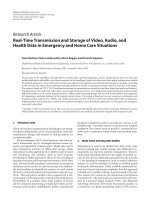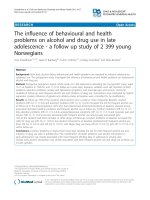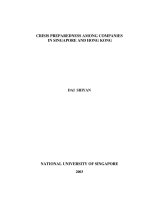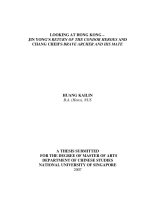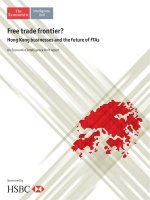ALCOHOL AND HEALTH: HONG KONG SITUATION
Bạn đang xem bản rút gọn của tài liệu. Xem và tải ngay bản đầy đủ của tài liệu tại đây (188.84 KB, 20 trang )
2 Alcohol and health: Hong Kong situation
2 Alcohol and
health:
Hong Kong
situation
13
2 Alcohol and health: Hong Kong situation
2. Alcohol and health: Hong Kong situation
Availability and price of alcohol in Hong Kong
2.1 Alcoholic beverages are readily accessible in Hong Kong. They are available for sale in retail
shops such as supermarkets and convenience stores, and in premises granted with liquor licence
including some restaurants and bars. There are also a variety of alcoholic beverages on the
market, such as beer, wine, spirits, Chinese rice wine and sake. A brief summary on the common
types of drinks available in Hong Kong and their alcohol content measured in “standard drink”
units is listed in Table 5 in Annex 436.
2.2 In 2008, there was a sharp drop in average price for wine and beer following a decrease in the
duty of wine and liquor with a low alcoholic strength (Figure 2).
Figure 2 : Price index of alcohol in Hong Kong, by type of alcohol, 1996-2009
Price index 120.0
110.0
100.0
90.0
0.0
1996 1997 1998 1999 2000 2001 2002 2003 2004 2005 2006 2007 2008 2009
Year
Average of all types of alcohol Chinese Rice Wine Wine and spirits Beer
Source: Consumer Price Index Section, Census and Statistics Department
36 A “standard drink” is equivalent to 10g of pure alcohol and is the measure of alcohol used to work out consumption. To calculate alcohol units in a drink,
the following formula is used:
No. of standard drink = Drink volume (ml) x alcohol content (% by volume) x 0.789 / 1 000
14
2 Alcohol and health: Hong Kong situation
Alcohol consumption per capita in Hong Kong
2.3 Alcohol consumption per capita is closely related to the prevalence of alcohol-related harm and
alcohol dependence at the population level. Alcohol consumption per capita in Hong Kong is
estimated by the following formula:
Alcohol consumption per capita Total alcohol consumption (A + B)
(litres of pure alcohol) = Population aged 15 years or above
where (A) = local consumption of locally produced alcohol beverages
= local production – export of locally produced alcohol
(B) = net import
= import – re-export
2.4 As the duty for wine and liquor with an alcoholic strength of less than 30% has been waived
since February 2008 and the related licensing/permit arrangement on zero-rated goods was
revoked, data for the estimation on local consumption of locally produced alcohol beverages (i.e.
(A) in the formula) was not available after February 2008. Estimation of the total and per capita
alcohol consumption in Hong Kong from 2004 to 2010, as shown in Table 3 and Figure 3, is based
on the assumption that local consumption of locally produced alcohol beverages of an alcoholic
strength of less than 30% in year 2008, 2009 and 2010 was the same as that in 2007.
15
2 Alcohol and health: Hong Kong situation
Table 3: Estimated total and per capita alcohol consumption in Hong Kong (in litres), 2004-2010#
Pure alcohol consumption Pure alcohol consumption Total pure alcohol consumption Population Alcohol
from local production (A) from net import (B)
= (A) + (B) aged consumption
Year Beer Wine Spirits Beer Wine Spirits Beer Wine Spirits ≥15 years per capita
2004 1 438 465 0 144 581 6 161 356 1 588 901 5 525 970 7 599 821 1 588 901 5 670 551 5 778 300 2.57
2005 1 328 790 0 172 328 6 283 786 1 770 057 5 204 485 7 612 576 1 770 057 5 376 813 5 844 300 2.53
2006 1 126 110 0 154 951 6 320 893 1 995 111 5 431 296 7 447 003 1 995 111 5 586 247 5 918 000 2.54
2007 1 359 455 0 164 088 6 139 077 2 379 850 5 763 158 7 498 532 2 379 850 5 927 246 6 004 700 2.63
2008 *1 359 455 0 *146 734 7 786 343 3 164 107 5 799 900 *9 145 798 3 164 107 *5 946 634 6 075 400 *3.00
2009 *1 359 455 0 *107 837 7 057 842 3 556 149 4 136 418 *8 417 297 3 556 149 *4 244 254 6 130 300 *2.65
2010 *1 359 455 0 *90 343 6 157 894 3 735 296 5 066 524 *7 517 349 3 735 296 *5 156 867 6 209 800 *2.64
Note: # the volume of pure alcohol consumed was estimated from the total volume of alcoholic beverages consumed by assuming that beer is 5% by
volume, wine is 13.5% by volume, and spirits ≤ 30% and spirits > 30% are 30% and 40% by volume respectively.
* figures estimated by assuming that local consumption of locally produced alcohol beverages with an alcoholic strength of less than 30% in year
2008, 2009 and 2010 was the same as that in 2007.
Figure 3: Estimated per capita alcohol consumption among Hong Kong adults, 2004-2010
Litres of alcohol 3.2
3.0
2.8 2005 2006 2007 2008 2009 2010
2.6 Year
2.4
2.2
2.0
1.8
1.6
1.4
1.2
1.0
0.8
0.6
0.4
0.2
0.0
2004
Source: Census and Statistics Department, and Customs and Excise Department
16
2 Alcohol and health: Hong Kong situation
2.5 When all types of alcohol are considered as a whole, the alcohol consumption per capita of
Hong Kong has been stable from 2004 to 2010, except for a surge in 2008 due to the increase in
alcohol consumption from beer and wine, as shown in Figure 3. This observation is consistent
with the evidence from overseas studies and experience that alcohol consumption was inversely
proportional to its price37. In 2009 and 2010, although the increase in wine consumption
persisted, such increase was offset by a significant reduction in spirits consumption due to an
increase in price. The alcohol consumption per capita in Hong Kong was estimated to be 2.64
litres in 2010 (1.21 litres of beer; 0.60 litres of wine and 0.83 litres of spirits), which has slightly
dropped from 3.0 litres in 2008.
2.6 Due to cultural, religious and economic differences, alcohol consumption per capita varies
greatly among countries. According to the WHO, Republic of Moldova had the highest alcohol
consumption per capita amounting 23.01 litres in 2008, whereas those in the Middle East region
were generally minimal due to religious reasons. In Asia, the Republic of Korea consumed 14.81
litres per capita; Japan consumed 7.79 litres per capita; China consumed 5.56 litres per capita;
Singapore consumed 1.54 litres per capita and Malaysia consumed 0.87 litres per capita in 2008
(Figure 4)38.
37 World Health Organization (2009). Evidence for the effectiveness and cost-effectiveness of interventions to reduce alcohol-related harm. Copenhagen: WHO
Regional Office for Europe. Available at: />
38 World Health Organization (2011). Global status report on noncommunicable diseases 2010. Geneva: World Health Organization.
17
2 Alcohol and health: Hong Kong situation
Figure 4: Per capita alcohol consumption among adults (>=15 years) in Hong Kong in year 2010 and
other regions/countries in year 2008
16
14
Litres of pure alcohol 12
10
8
6
4
2
0 Malaysia Singapore Hong Kong China Japan United United Republic of
Kingdom Korea
States of
Sources: America
Regions other than Hong Kong: World Health Organization
Hong Kong: Census and Statistics Department, and Customs and Excise Department
2.7 However, according to the International Wine and Spirits Report 2010 study conducted by the
trade, Hong Kong consumed 3.5 litres of wine per capita in 2008 (= 0.47 litres of pure alcohol,
assuming that wine has 13.5% alcohol by volume), which was the highest and significantly ahead
of other neighbouring countries in Asia such as Japan and Singapore (Figure 5)39.
Figure 5: Wine consumption per capita among selected Asian countries/cities in 2008
Wine consumption per capita (litres) 4.0
3.5
3.0 Japan Hong Kong
2.5
2.0
1.5
1.0
0.5
0.0 Singapore
Source: International Wine and Spirits Report 2010 Study
39 International Wine and Spirits Report 2010 ( )
18
2 Alcohol and health: Hong Kong situation
2.8 Although per capita consumption provides an overall estimate of alcohol consumed in
Hong Kong, survey data are needed to link the consumption data with factors such as socio-
demographic variables and alcohol-related harm at the individual level, which will be presented
in the following paragraphs.
Local epidemiology of alcohol consumption behaviour and risk perception
Data sources for surveillance of alcohol consumption behaviour and risk perception
2.9 The DH, in collaboration with the Department of Community Medicine of the University of Hong
Kong, conducted a population-based health survey (Population Health Survey, PHS) in 2003/2004
to report the patterns of health status and health-related issues of the general population in
Hong Kong, including alcohol use. Around 7 000 land-based non-institutionalised population of
Hong Kong (excluding foreign domestic helpers) aged 15 years and over were interviewed.
2.10 Following the initial assessment through the PHS in 2003/2004, the DH has continuously
monitored the alcohol consumption behaviour of the local adult population, among other
behavioural risk factors, through the Behavioural Risk Factor Surveillance System (BRFSS) since
2004. The BRFSS comprises a series of surveys conducted regularly enumerating about 2 000
people aged 18 - 64 years.
2.11 As for the surveillance among children and youth, the DH conducted the first population-based
Child Health Survey (CHS) in 2005/2006 to collect health information of local children aged 14
years and below, including alcohol use. Separately, the Narcotics Division of the Security Bureau
(ND) has been conducting a series of surveys of around 100 000 adolescent students every 4
years since 1992 about their use of alcohol (among other drug uses), the majority of whom
were studying in secondary schools or equivalent. In the survey conducted in 2008, students in
primary 4 to 6 and university were also included.
2.12 Apart from surveys, some local researchers also conducted ad-hoc qualitative and quantitative
studies to investigate risk perception and patterns of alcohol consumption in different
populations.
19
2 Alcohol and health: Hong Kong situation
Alcohol consumption behaviour in the adult general population
2.13 The PHS in 2003/2004 revealed that 23.7% of the respondents (persons aged 15 years and above
in Hong Kong) drank alcohol occasionally (drink 3 days or less a month); 9.4% were regular
alcohol consumers drinking at least once a week; 61.6% were non-drinkers; and 4.7% were ex-
drinkers. Among the drinkers, the majority (66.5%) reported that they usually drank beer, 19.6%
drank table wine, whereas 10.6% drank Chinese rice wine and 6.9% drank spirits40.
2.14 According to the PHS in 2003/2004, the prevalence of drinking was different between males
and females. The male to female ratio among current drinkers was about 2:1. The proportions
of current drinkers among males and females were 45.3% and 23.2% respectively. In addition, a
higher proportion of men (11.3%) than women (3.7%) drank alcohol everyday. On the contrary,
a higher proportion of females (84.0%) than males (63.6%) among current drinkers drank alcohol
occasionally (drink 3 days or less a month).
2.15 Results of the BRFSS showed that there was an increase of 4.0 percentage points of the drinking
prevalence among adult population in Hong Kong (i.e. proportion of people reported to have
consumed at least one alcoholic drink during the 30 days prior to the survey), from 30.9% in
2005 to 34.9% in 2010. In particular, the rise in the drinking prevalence in females was steeper
(5.1 percentage points), from 19.5% in 2005 to 24.6% in 201041. This finding warrants concern
for several reasons. Firstly, women are more vulnerable to the effects of alcohol because of their
smaller physical build compared to men. Secondly, addiction to alcohol can be particularly
hazardous for existing or subsequent pregnancies. Thirdly, women play a primary role in
managing households and children in Asia. This primary responsibility can be seriously affected
if women are habituated to alcohol42.
2.16 Also, according to the Behavioural Risk Factor Survey (BRFS) of 2010, 16.9% reported drinking
beyond the recommended daily limit (exceeding 2 standard drinks for men and 1 standard drink
for women on average on any drinking day), and 5.8% reported drinking so much that they
exhibited signs of drunkenness (such as flushed face or reddened eyes, slurred or incoherent
speech, unsteady or staggering gait, vomiting and hangover on the next day) during the month
prior to the study.
40 Population Health Survey 2003/2004. Hong Kong SAR: Department of Health and Department of Community Medicine, University of Hong Kong.
41 Behavioral Risk Factor Surveillance System. Hong Kong SAR: Department of Health.
42 WHO Regional Office for South-East Asia (2003). Need for a Regional Alcohol Action Plan: 21st Meeting of Ministers of Health New Delhi, India, 8-9 September
2003. Available at: />
20
2 Alcohol and health: Hong Kong situation
Alcohol consumption behaviour in the younger population
2.17 The CHS of 2005/2006 showed that 5.0% of children aged 11 to 14 years were ever alcohol users
and 0.3% were current binge drinkers (who had five or more drinks of alcohol in a row within
a couple of hours in the past month). Furthermore, the PHS in 2003/2004 showed that the
prevalence of underage drinking (reported to have started drinking before 18 years of age) was
higher among the younger cohorts43 (Figure 6).
Figure 6: Proportion of respondents started drinking below age of 18 by age group
Proportion (%) 30 13.09% 16.27%
25
20 7.84% 7.72% 7.73% 10.36%
15 65-74
10 7.28% 55-64 45-54 35-44 25-34 15-24
5
0
75 or
above
Age group (years)
Source: Population Health Survey, 2003/2004
2.18 According to the most recent survey (2008) conducted by the ND, 64.9% of students studying in
secondary schools had ever consumed alcohol. Furthermore, 24.2% of the secondary students
reported that they had consumed alcohol in the preceding month44.
43 Child Health Survey 2005/2006. Hong Kong SAR: Department of Health.
44 The 2008/2009 Survey of Drug Use among Students. Hong Kong SAR: Narcotics Division of Security Bureau. Available at: />
survey_drug_use/2008-2009/Report.pdf
21
2 Alcohol and health: Hong Kong situation
Binge drinking
2.19 Apart from drinking frequency and the total amount consumed, alcohol consumption pattern,
e.g. binge drinking, was another important aspect leading to alcohol-related harm. The BRFSS
defines binge drinking as reported drinking of at least 5 cans/glasses of alcohol beverages on
one occasion during the month prior to the survey, which is equivalent to an average of 62.5
grams (50 to 75 grams) of pure alcohol consumed in both men and women. In 2010, the BRFS
revealed that about 7.2% of the respondents were binge drinkers. It is worth noting that there
was a higher proportion of binge drinkers among young adults. Among the various age groups,
the highest proportion of binge drinkers was found in age group 25 – 34 in males (15.6%) and
age group 18 – 24 in females (4.6%) (Figure 7).
Figure 7: Prevalence of binge drinking by sex and age group, 2010, Hong Kong
20
15 15.6
Proportion (%) 14.3 12.8
12.3 10.9
10 10.3 9.0
7.4 7.2 6.5 5.8 7.2
1.9 1.2 0.7 2.4
5 4.6 4.2
0 25-34 35-44 45-54 55-64 Overall
18-24 (including
Age group (years) missing
ages)
Male Female Overall
Source: Behavioural Risk Factor Survey (2010)
22
2 Alcohol and health: Hong Kong situation
2.20 A local random telephone survey conducted among about 10 000 Chinese adults in Hong
Kong in 2006 showed that the age-adjusted prevalence of binge drinking among adult men
and women were 14.4% and 3.6% respectively. The prevalence of binge drinking was higher
in younger age groups. An age distribution of binge drinkers similar to that in the BRFS was
observed. The prevalence of binge drinking were 23.3% and 12.3% in 21-30 year-old and 18-20
year-old men respectively; whereas the prevalence were 8.7% and 6.3% in 21-30 year-old and
18-20 year-old women respectively45. These findings were consistent with those in the BRFS
and showed that binge drinking is a relatively common phenomenon among the younger age
groups in Hong Kong.
2.21 In another local survey of 3 000 university students in 2003, the prevalence of binge drinking
was found to be 7% (12% among men, 3% among women)46. The study found that although
the majority of first year university students in Hong Kong were not binge or regular drinkers in
contrast with students in the West, there was a subgroup that drank more and used alcohol as a
means of coping with stress.
Public awareness of harmful effects of alcohol and social/cultural meaning of drinking
2.22 It should be noted that despite its health effects, alcohol does play an important social and
cultural role in society. In Chinese culture, alcohol may sometimes be treated as traditional
health or medicinal products and may also be consumed during social events and collective
celebrations, although drunkenness is usually frowned upon by the Chinese society47.
2.23 Such cultural endorsement of drinking is also observed among Hong Kong people including
youngsters and may affect their risk perception. A recent local study found that the perception
of risk on alcohol use was low in a representative group of university students in Hong Kong45.
In another exploratory study on local young people’s views on both positive and negative
consequences of alcohol use, female youngsters perceived that drinking made it easier for them
to interact with others, and male youngsters considered that alcohol promoted relaxation and
enhanced sleep onset48. For negative consequences, male youngsters’ response was limited to
physical effects such as flushing and drowsiness, whereas female respondents added strained
relationships, irresponsible behaviour and accidents.
45 Kim JH, Lee S, Chow J et al. (2008). Prevalence and the factors associated with binge drinking, alcohol abuse, and alcohol dependence: a population-
based study of Chinese adults in Hong Kong. Alcohol & Alcoholism, 43(3):360-370.
46 Griffiths S, Lau JT, Chow JK et al. (2006). Alcohol use among entrants to a Hong Kong University. Alcohol & Alcoholism, 41(5):560-565.
47 郭萬軍 等 (2007)。社會經濟文化變遷對酒精消費及其相關健康問題的影響─世界衞生組織及社會經濟文化快速變遷地區和國家的研究。 國際精
神病學雜誌,34(3): 168-171。
48 Lo CC, Globetti G (2000). Gender differences in drinking patterns among Hong Kong Chinese youth: a pilot study. Subst Use Misuse, 35(9):1297-1306.
23
2 Alcohol and health: Hong Kong situation
Local epidemiology of alcohol-related harm
Data sources for surveillance of alcohol-related harm
2.24 Statistics on alcohol-related hospital admissions and deaths are routinely collected by the
Hospital Authority (HA). Statistics on traffic accidents associated with drink-driving are also
regularly collected by the Transport Department (TD).
Alcohol-related hospital admissions
2.25 In 2009, alcohol-related illness or injuries (ICD-10: F10, K70 and X45) accounted for a total of
2 433 admissions into public/private hospitals in Hong Kong. More men than women were
affected with a male to female ratio of about 5 to 1. Mental and behavioural disorders due to
use of alcohol (73.6%) and alcoholic liver disease (26.4%) accounted for the majority of these
admissions.
2.26 As shown in Figure 8, the number of alcohol-related admissions into public hospitals in 2009
was similar to those in the previous 6 years. The number of alcohol-related admissions into
private hospitals was relatively small, amounting to fewer than 30 in 2009. However, it must
be cautioned that only those admissions with alcohol-related disease marked as the principal
diagnosis were counted and therefore it is expected that the figures have significantly under-
estimated the disease burden related to alcohol.
Figure 8: Number of alcohol-related admissions in HA hospitals, by principal diagnosis and by year,
2003-2009
Number of alcohol-related 3000
admissions to 2500
2000
Hospital Authority hospitals 1500
1000
2003 2004 2005 2006 2007 2008 2009
500
0
mental and behavioural disorders accidental poisoning by and
due to use of alcohol exposure to alcohol
alcoholic liver disease Total
Sources: Census and Statistics Department, Department of Health & Hospital Authority
24
2 Alcohol and health: Hong Kong situation
Alcohol-related deaths
2.27 In 2009, alcohol-related deaths (ICD-10: F10, K70 and X45) contributed to 0.14% of locally
registered deaths in Hong Kong (58 out of 41 047). Of these, 48, 6 and 4 deaths (82.8%, 10.3%
and 6.9% of the total number of alcohol-related deaths) were related to alcoholic liver disease,
accidental poisoning by alcohol, and mental and behavioural disorders respectively. More men
than women were affected with a ratio of about 9 to 1. Men aged 45 years or above accounted
for 50 deaths (86.2% of the total number of alcohol-related deaths) in 2009. The trend was stable
in the past 6 years (Figure 9). Nonetheless, taking similar limitations in hospital admissions
statistics into account, significant under-estimation needs to be considered.
Figure 9: Number of alcohol-attributed registered deaths, by cause of deaths and by year, 2003-
2009
Number of registered 80
alcohol-related deaths 70
60
50 2004 2005 2006 2007 2008 2009
40
30
20
10
0
2003
mental and behavioural disorders accidental poisoning by and
due to use of alcohol exposure to alcohol
alcoholic liver disease Total
Sources: Census and Statistics Department, Department of Health & Hospital Authority
25
2 Alcohol and health: Hong Kong situation
Drink-driving
2.28 A local random telephone survey conducted among 9 860 Chinese adults aged 18-70 years in
Hong Kong in 2006 showed that the age-standardised past-year prevalence of driving within 2
hours of drinking among males and females were 5.2% and 0.8% respectively. The prevalence of
drinking and driving across age showed an inverted U-shaped trend for males peaking at 8.2%
between 36 and 45 years, while the prevalence was fairly stable between 26 and 55 years for
females. The age-adjusted past-year prevalence of alcohol-related motor vehicle accidents was
0.15% among males and 0.02% among females, with the majority being in the 26-35 age group49.
2.29 Drink-driving increases the risk of road traffic accidents. A local epidemiological study in 2001
showed that about one in ten (10.3%) of all motor vehicle deaths were associated with alcohol50.
According to the statistics from the TD, between 2000 and 2010, 874 vehicle accidents resulting
in personal injury were related to alcohol use, including 24 fatal cases. An overall increasing
trend was observed from year 2000 to 2008 (Figure 10), but then a sharp drop was seen in 2009
and 2010 following the implementation of random breath test from February 2009.
Figure 10: Number of drivers found to have consumed alcohol and involved in road traffic accidents
by severity and by year, 2000-2010, Hong Kong
Number of cases of alcohol-related 120 2001 2002 2003 2004 2005 2006 2007 2008 2009 2010
road traffic accidents 100
80
60
40
20
0
2000
Fatal Serious Slight Total
Source: Transport Department
49 Kim H et al. (2010). A population-based study on the prevalence and correlates of drinking and driving in Hong Kong. Accident Analysis and Prevention,
42: 944-1002.
50 Cameron PA, Rainer TH, Mak P (2004). Motor vehicle deaths in Hong Kong: opportunities for improvement. Journal of Trauma, 56(4):890-893.
26
2 Alcohol and health: Hong Kong situation
Domestic violence and sexual assault
2.30 Alcohol consumption triggers the occurrence and aggravates the severity of domestic violence
and sexual assault. Currently, there is no up-to-date data on the local prevalence of domestic
violence or sexual assault related to alcohol. Nonetheless, one local study found that alcohol
abuse by the husband was a significant risk factor for domestic violence injuries among married
women51. According to the statistics of the Family Planning Association of Hong Kong, the
number of calls for help from victims sexually-assaulted under the influence of drug or alcohol
ranged from 4 to 32 in the period from 2000 to 2006 (Figure 11).
Figure 11: Number of calls for help from victims sexually assaulted under the influence of drug or
alcohol, 2000-2006
Number of sexually assaulted victim 35 2001 2002 2003 2004 2005 2006
under the influence of drug or alcohol 30
25 Year
20
15
10
5
0
2000
Source: Family Planning Association of Hong Kong
51 Tsui KL, Chan AY, So FL, Kam CW (2006). Risk factors for injury to married women from domestic violence in Hong Kong. Hong Kong Medical Journal,
12(4):289-293.
27
2 Alcohol and health: Hong Kong situation
Local interventions to reduce alcohol-related harm
Raising public awareness to prevent alcohol-related harm
2.31 Currently, various government departments and local organisations actively participate in the
prevention of alcohol-related harm. For example, the DH provides printed materials, 24-hour
education hotline, website (Men’s Health Programme) and electronic publications (“NCD Watch”)
to educate the public on the prevention of alcohol-related harm. The Tung Wah Group of
Hospitals (TWGHs) and Tuen Mun Alcohol Problems Clinic of HA provide pamphlets and website
for public education. The Education Bureau promotes healthy lifestyles, including prevention of
alcohol use, to students through a holistic school curriculum which comprises knowledge, skills
and attitudes. To support the delivery of the curriculum in schools, professional development
programmes and resource materials are available for principals and teachers. Moreover, all
schools are encouraged to implement the school-based Healthy School Policy starting from the
2010/11 school year. The TD, Road Safety Council, and the Hong Kong Police Force (HKPF) have
produced Announcements in the Public Interest about drink-driving prevention for broadcast on
TV and radio. Anti-drink-driving slogans are displayed on banners and advertisement boards to
remind the public not to drive if they drink.
Health sector response on alcohol-related harm
2.32 In the public sector, the Tuen Mun Alcohol Problems Clinic of the HA provides various services
including (a) comprehensive assessment; (b) alcohol detoxification; (c) treatment of co-existing
psychiatric and psychological problems; (d) marital counselling, family therapy and social work
service; (e) organisation of self-help group; and (f ) referral to other treatment services. The
other six substance abuse clinics of the HA also provide treatment services on alcohol-related
problems upon referrals.
28
2 Alcohol and health: Hong Kong situation
2.33 The NGOs contribute significantly to health services for people with alcohol-related problems.
A special project known as “Stay Sober, Stay Free” run by the TWGHs provides comprehensive
assessment, treatment and counselling services through a multi-disciplinary team including
doctors, nurses, clinical psychologists, social workers and occupational therapists. Clients would
be appropriately referred to in-patient treatment services, and would be offered family support
service, hotline service and voluntary service as well as activities on well-balanced living by the
project. Alcoholics Anonymous, a worldwide organisation, also provides local alcohol users with
volunteer-conducted support group and alcohol abstinence services.
Drink-driving legislation and relevant alcohol-related harm reduction measures
2.34 According to the Road Traffic Ordinance (Cap. 374, Reg 39A), it is illegal for a person to drive
or attempt to drive a motor vehicle, or be in possession of a motor vehicle, on any road with
the proportion of alcohol in his breath, blood or urine exceeding the prescribed limit. Since 1
October 1999, the prescribed limit for drink-driving has been set as follows:
• 50 milligrams of alcohol per 100ml of blood; or
• 22 micrograms of alcohol per 100ml of breath; or
• 67 milligrams of alcohol per 100ml of urine.
2.35 With effect from 9 February 2009, uniformed police officers can require a person who is driving
or attempting to drive a vehicle on a road to perform an alcohol breath test without the need
for reasonable suspicion (Cap. 374, Reg 39B). The maximum fine for a person breaching the
prescribed limit is HK$25,000 and imprisonment for up to 3 years. With effect from 17 December
2010, 3-tier penalty system with a sliding scale was also introduced. The more a driver exceeds
the prescribed limit for alcohol, the longer will be the driving disqualification period. The
minimum disqualification period for drink drivers on first conviction is 6 months to 2 years; and
on subsequent conviction is 2 to 5 years.
2.36 Some NGOs such as the Hong Kong Automobile Association have also started some designated
driver services, which provide designated sober drivers to drive those who have consumed
alcohol to return home.
29
2 Alcohol and health: Hong Kong situation
Measures to control the availability of alcohol
2.37 It is an offence under the Dutiable Commodities (Liquor) Regulations (Cap. 109B) to sell liquor
except on the authority of a liquor licence or a temporary liquor licence at any premises for
consumption on those premises; or at a place of public entertainment or a public occasion for
consumption at the place or occasion. It also stated that “no licensee shall permit any person
under the age of 18 years to drink any intoxicating liquor on any licensed premises”.
2.38 However, there is currently no restriction on the minimum age for off-premise sales of alcohol in
Hong Kong. Some organisations have adopted a voluntary code of conduct to restrict the sale of
alcohol to young people. For example, the Hong Kong Retail Management Association, which is
the major retail association in Hong Kong with more than 5 000 retail outlets, states in their code
of conduct that its members should not sell any alcoholic beverages to people aged under 18
years.
Measures to control the marketing of alcohol beverages
2.39 Under the Broadcasting Ordinance (Cap. 562) and the Broadcasting Authority Ordinance (Cap.
391), all television programme service licensees have to comply with the Codes of Practice issued
by the Broadcasting Authority. Under the Codes of Practice, there are restrictions on advertising
alcoholic beverages to young people, some examples of which include:
• such advertising should only target the adult audience;
• such matters should not be advertised in proximity to children's programmes; or
programmes which target young persons under the age of 18;
• the licensee should not broadcast any such advertisement between the hours of 4:00 p.m.
and 8:30 p.m.;
• such advertisements must not feature any personality whose example children or young
persons are likely to follow or who has a particular appeal to children or young persons
under the age of 18; and
• advertising must not encourage, challenge or dare non-drinkers or young persons under
the age of 18 to drink.
Pricing Policies
2.40 The duty on beer and wine has been exempted since February 2008. For spirits with 30% alcohol
by volume (ABV), the duty is 100%.
30
2 Alcohol and health: Hong Kong situation
Knowledge gaps identification and situation analysis
Knowledge gaps in alcohol use and alcohol-related harm in Hong Kong
2.41 A good surveillance system is essential to the accurate determination of the size and nature
of alcohol use and alcohol-related harm in Hong Kong. Although a number of information
sources are available, they are uncoordinated and there is still inadequate research to identify
and examine the risk factors and protective factors of alcohol use in Hong Kong. Moreover,
surveillance on alcohol consumption and its related harm is incomplete. There is a lack of
information on violence or alcohol-related assault in particular.
Size and nature of alcohol use and alcohol-related harm
2.42 The BRFSS showed that a significant proportion (15.3%) of adults drank beyond the
recommended daily limit and there was a rise in the proportion of drinkers from 2005 to 2010
in Hong Kong adult population. It is worth noting that the proportion of female drinkers was
increasing from 2005 to 2010 although fewer females drank than males in general52. Different
local studies consistently showed that binge drinking was prevalent in younger age groups (18-
30 years old)53. Furthermore, an increasing prevalence of underage drinking in the younger
cohorts was noted from the PHS in 2003/200454. As for alcohol-related harm, various sources
of information have demonstrated that alcohol use contributed to significant loss of lives and
disease burden in Hong Kong55,56.
Public awareness and current health education of alcohol-related harm
2.43 While the perceived benefits of drinking (proven and unproven) such as prevention of heart
disease, improving sleep onset and maintenance of general health are better known in Hong
Kong57, public awareness of the harmful effects of alcohol needs to be strengthened.
52 Behavioral Risk Factor Surveillance System. Hong Kong SAR: Department of Health.
53 Kim JH, S Lee, J Chow, et al. (2008). Prevalence and the factors associated with binge drinking, alcohol abuse, and alcohol dependence: a population-
based study of Chinese adults in Hong Kong. Alcohol & Alcoholism, 43(3):360-370.
54 Population Health Survey 2003/2004. Hong Kong SAR: Department of Health and Department of Community Medicine, University of Hong Kong.
55 Census and Statistics Department, Department of Health, Hospital Authority and Transport Department, Hong Kong SAR Government.
56 Cameron Pa, TH Rainer, P Mak (2004). Motor vehicle deaths in Hong Kong: opportunities for improvement. Journal of Trauma, 56(4):890-893.
57 Lo CC, Globetti G (2000). Gender differences in drinking patterns among Hong Kong Chinese youth: a pilot study. Subst Use Misuse, 35(9):1297-1306.
31
2 Alcohol and health: Hong Kong situation
Health sector response and community action
2.44 At present, there are some treatment and support services for people with alcohol-related
problems provided by the public sector and the NGOs. Nonetheless, there is room for
improvement in terms of active early identification and treatment.
2.45 Reducing alcohol-related harm has not been a popular agenda in community health actions and
can be accorded a higher priority in policy agenda through enhanced preventive and control
measures involving more government bureaux/departments.
Drink-driving policies and relevant harm-reduction measures
2.46 With the recent legislation of random alcohol breath tests that can be performed by uniformed
police officers and the related education and publicity measures, it is worthwhile to study its
effect on drink-driving.
Measures to control the availability of alcohol
2.47 Currently, there is no restriction on the minimum age for off-premise sales of alcohol in Hong
Kong. Only some organisations have adopted a voluntary code of conduct to restrict the sale of
alcohol to young people.
Measures to control the marketing of alcohol beverages
2.48 Restrictions on advertising alcoholic beverages to young people are only applicable to television
programme service licensees. To date, there is no restriction on other forms of marketing and
promotion of alcoholic beverages which are commonly accessible to children and young people.
Pricing Policies
2.49 In Hong Kong, duty on beer and wine has been waived since February 2008, while the duty
is 100% for spirit of more than 30% alcohol by volume. This has made beer and wine more
affordable, which may increase alcohol consumption in the population. However, alcohol pricing
and its effect on consumption in the local setting warrants further study.
32



